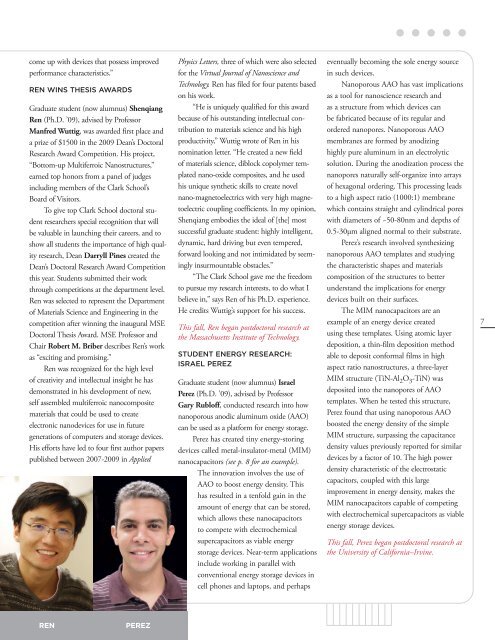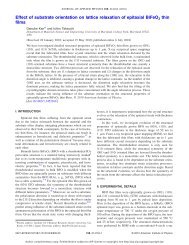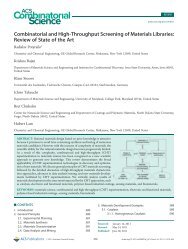Fall 2009 - Materials Science and Engineering - University of Maryland
Fall 2009 - Materials Science and Engineering - University of Maryland
Fall 2009 - Materials Science and Engineering - University of Maryland
You also want an ePaper? Increase the reach of your titles
YUMPU automatically turns print PDFs into web optimized ePapers that Google loves.
come up with devices that possess improvedperformance characteristics.”Ren Wins thesis awardsGraduate student (now alumnus) ShenqiangRen (Ph.D. ’09), advised by Pr<strong>of</strong>essorManfred Wuttig, was awarded first place <strong>and</strong>a prize <strong>of</strong> $1500 in the <strong>2009</strong> Dean’s DoctoralResearch Award Competition. His project,“Bottom-up Multiferroic Nanostructures,”earned top honors from a panel <strong>of</strong> judgesincluding members <strong>of</strong> the Clark School’sBoard <strong>of</strong> Visitors.To give top Clark School doctoral studentresearchers special recognition that willbe valuable in launching their careers, <strong>and</strong> toshow all students the importance <strong>of</strong> high qualityresearch, Dean Darryll Pines created theDean’s Doctoral Research Award Competitionthis year. Students submitted their workthrough competitions at the department level.Ren was selected to represent the Department<strong>of</strong> <strong>Materials</strong> <strong>Science</strong> <strong>and</strong> <strong>Engineering</strong> in thecompetition after winning the inaugural MSEDoctoral Thesis Award. MSE Pr<strong>of</strong>essor <strong>and</strong>Chair Robert M. Briber describes Ren’s workas “exciting <strong>and</strong> promising.”Ren was recognized for the high level<strong>of</strong> creativity <strong>and</strong> intellectual insight he hasdemonstrated in his development <strong>of</strong> new,self assembled multiferroic nanocompositematerials that could be used to createelectronic nanodevices for use in futuregenerations <strong>of</strong> computers <strong>and</strong> storage devices.His efforts have led to four first author paperspublished between 2007-<strong>2009</strong> in AppliedPhysics Letters, three <strong>of</strong> which were also selectedfor the Virtual Journal <strong>of</strong> Nanoscience <strong>and</strong>Technology. Ren has filed for four patents basedon his work.“He is uniquely qualified for this awardbecause <strong>of</strong> his outst<strong>and</strong>ing intellectual contributionto materials science <strong>and</strong> his highproductivity,” Wuttig wrote <strong>of</strong> Ren in hisnomination letter. “He created a new field<strong>of</strong> materials science, diblock copolymer templatednano-oxide composites, <strong>and</strong> he usedhis unique synthetic skills to create novelnano-magnetoelectrics with very high magnetoelectriccoupling coefficients. In my opinion,Shenqiang embodies the ideal <strong>of</strong> [the] mostsuccessful graduate student: highly intelligent,dynamic, hard driving but even tempered,forward looking <strong>and</strong> not intimidated by seeminglyinsurmountable obstacles.”“The Clark School gave me the freedomto pursue my research interests, to do what Ibelieve in,” says Ren <strong>of</strong> his Ph.D. experience.He credits Wuttig’s support for his success.This fall, Ren began postdoctoral research atthe Massachusetts Institute <strong>of</strong> Technology.Student ENERGY research:Israel PerezGraduate student (now alumnus) IsraelPerez (Ph.D. ’09), advised by Pr<strong>of</strong>essorGary Rubl<strong>of</strong>f, conducted research into hownanoporous anodic aluminum oxide (AAO)can be used as a platform for energy storage.Perez has created tiny energy-storingdevices called metal-insulator-metal (MIM)nanocapacitors (see p. 8 for an example).The innovation involves the use <strong>of</strong>AAO to boost energy density. Thishas resulted in a tenfold gain in theamount <strong>of</strong> energy that can be stored,which allows these nanocapacitorsto compete with electrochemicalsupercapacitors as viable energystorage devices. Near-term applicationsinclude working in parallel withconventional energy storage devices incell phones <strong>and</strong> laptops, <strong>and</strong> perhapseventually becoming the sole energy sourcein such devices.Nanoporous AAO has vast implicationsas a tool for nanoscience research <strong>and</strong>as a structure from which devices canbe fabricated because <strong>of</strong> its regular <strong>and</strong>ordered nanopores. Nanoporous AAOmembranes are formed by anodizinghighly pure aluminum in an electrolyticsolution. During the anodization process thenanopores naturally self-organize into arrays<strong>of</strong> hexagonal ordering. This processing leadsto a high aspect ratio (1000:1) membranewhich contains straight <strong>and</strong> cylindrical poreswith diameters <strong>of</strong> ~50-80nm <strong>and</strong> depths <strong>of</strong>0.5-30µm aligned normal to their substrate.Perez’s research involved synthesizingnanoporous AAO templates <strong>and</strong> studyingthe characteristic shapes <strong>and</strong> materialscomposition <strong>of</strong> the structures to betterunderst<strong>and</strong> the implications for energydevices built on their surfaces.The MIM nanocapacitors are anexample <strong>of</strong> an energy device createdusing these templates. Using atomic layerdeposition, a thin-film deposition methodable to deposit conformal films in highaspect ratio nanostructures, a three-layerMIM structure (TiN-Al 2 O 3 -TiN) wasdeposited into the nanopores <strong>of</strong> AAOtemplates. When he tested this structure,Perez found that using nanoporous AAOboosted the energy density <strong>of</strong> the simpleMIM structure, surpassing the capacitancedensity values previously reported for similardevices by a factor <strong>of</strong> 10. The high powerdensity characteristic <strong>of</strong> the electrostaticcapacitors, coupled with this largeimprovement in energy density, makes theMIM nanocapacitors capable <strong>of</strong> competingwith electrochemical supercapacitors as viableenergy storage devices.This fall, Perez began postdoctoral research atthe <strong>University</strong> <strong>of</strong> California–Irvine.7RENPEREZ












